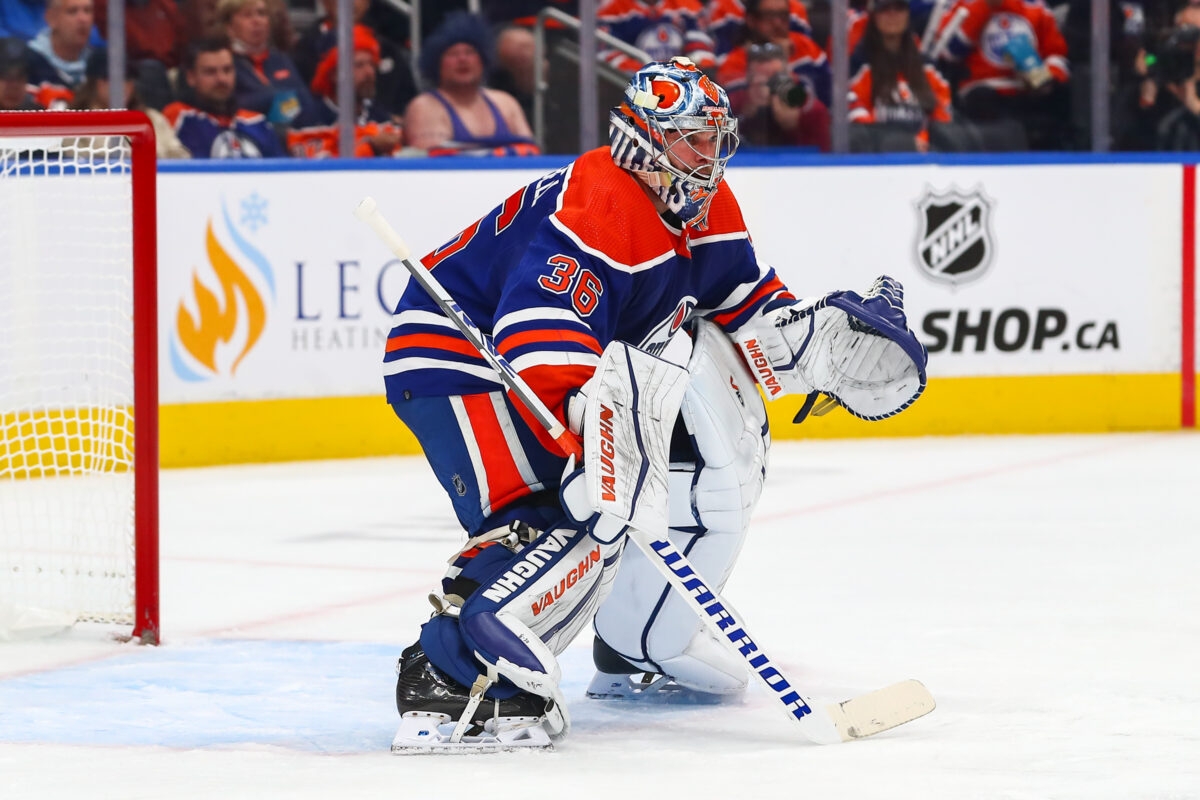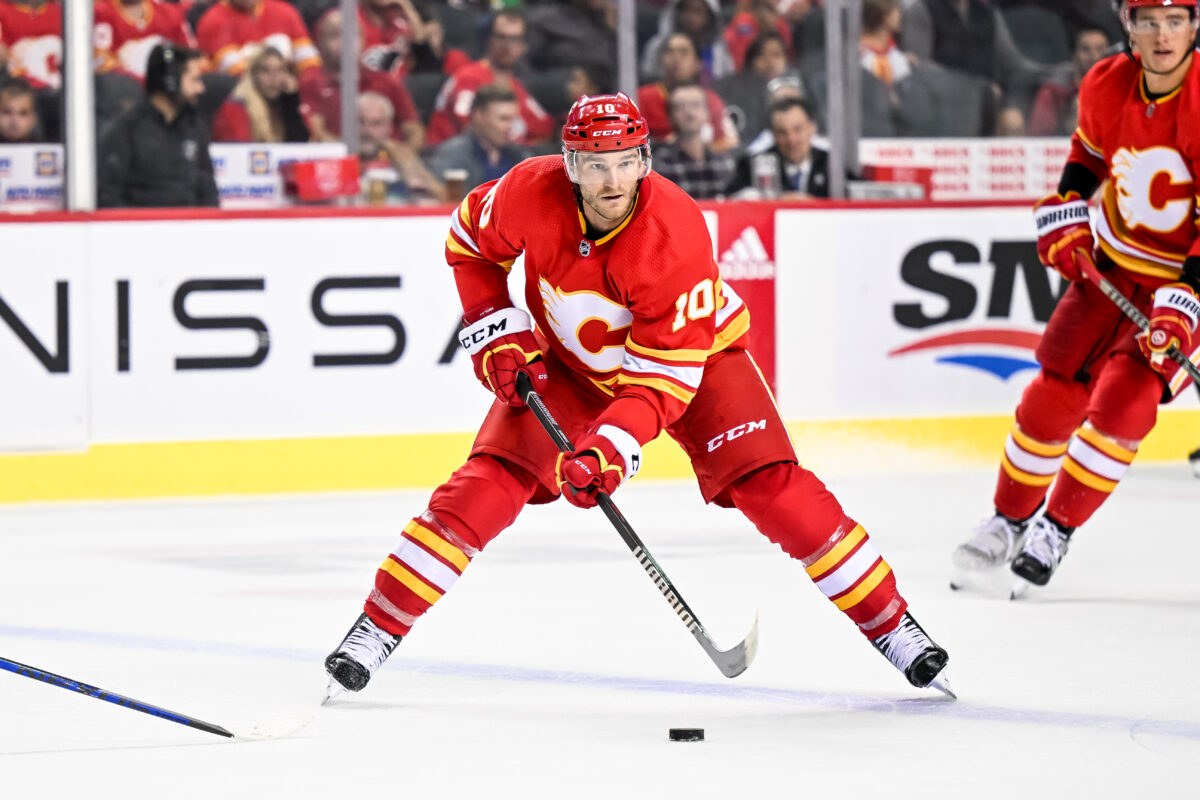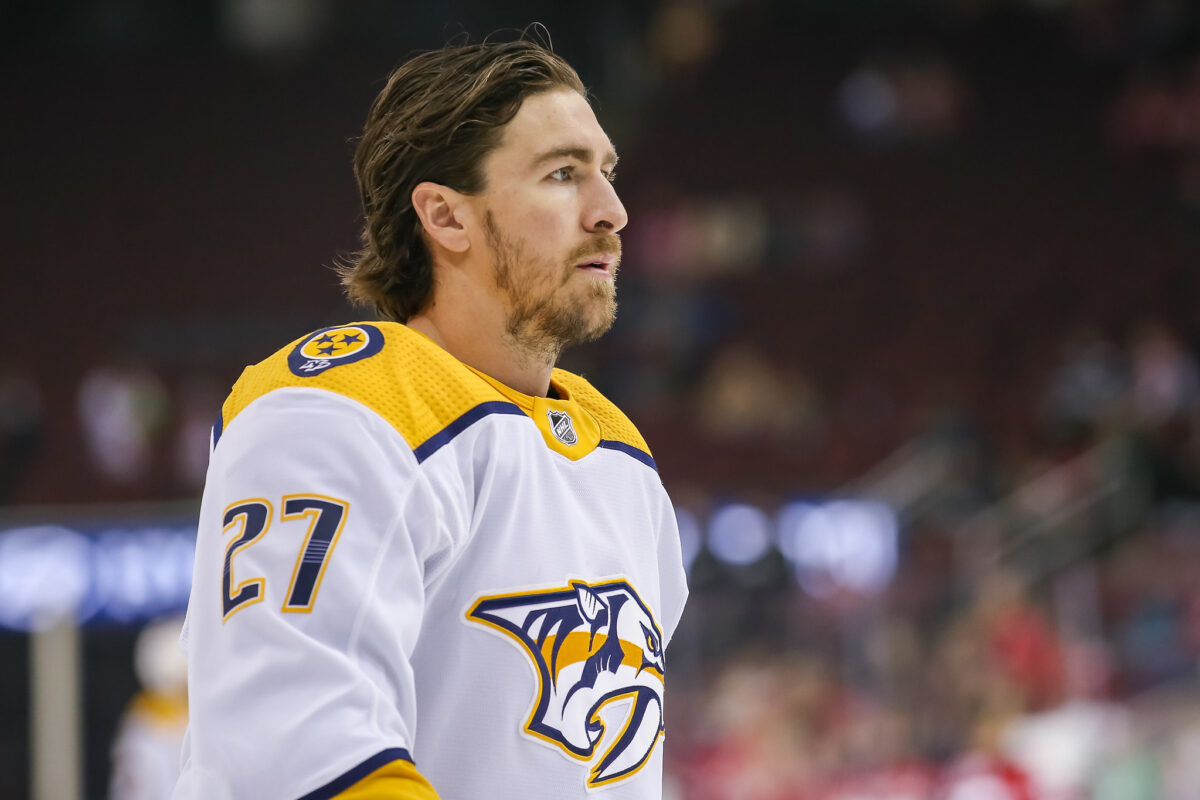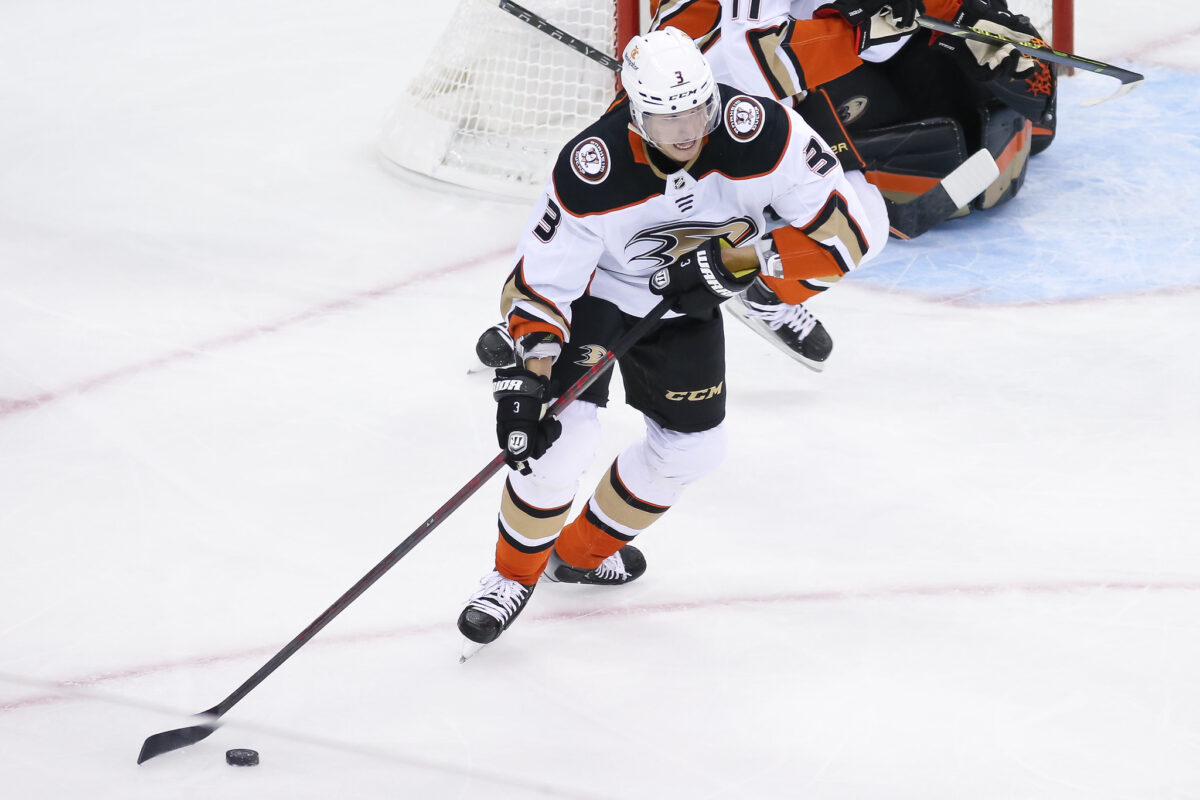Given that we’re almost at the halfway point of the 2022-23 season and with a new year just around the corner, now is the perfect time to highlight a few of the most disappointing performances of the season. With several big names changing locales this past offseason, there was no shortage of qualified nominees itching for the spotlight.
Coming up with candidates for this list was accomplished by looking at a player’s reputation and expectations heading into the season. Some viable picks (such as the Florida Panthers’ Sergei Bobrovsky or the Detroit Red Wings’ Ben Chiarot) have been underwhelming for a while now, so their continued struggles do not come as much of a surprise.
Related: The 5 Most Surprising Players of the 2022-23 NHL Season So Far
As a result, most if not all of those highlighted are bigger names, with their play grading out as significantly worse than others from a relative standpoint. Some of the underperformance can be chalked up to simple bad luck, but that doesn’t take away from the fact that the players have underdelivered on expectations. Even though the holiday season is in full swing, we can only extend our graciousness so far.
So, without further ado, here are the season’s five most disappointing players (and five additional dishonourable mentions) so far; let’s dive in.
Jack Campbell, Edmonton Oilers
2022-23 Statistics: 15 Games Played (GP) / 8 Wins (W) / 6 Losses (L) / 1 Overtime Loss (OTL) / .876 Save Percentage (SV%) / minus-10.8 Goals Saved Above Expected (GSAx)
It seems like the Toronto Maple Leafs and general manager (GM) Kyle Dubas were right to pass on Jack Campbell after all. Now a member of the Edmonton Oilers, the 30-year-old netminder has significantly underperformed since signing a five-year, $25 million contract this past summer. His $5 million average annual value (AAV) puts him in a tie for 13th among the highest-paid goalies for the 2022-23 season. For that class of investment, one would expect more than a statistical resume that looks like it belongs to an American Hockey League (AHL) journeyman.
Among 58 goalies to have played in at least 10 games this season, Campbell ranks 54th in SV% (.876), 55th in goals-against average (4.02 GAA) and allowed nearly 11 goals more than expected (54th in GSAx). He’s all but ceded the net to 24-year-old Stuart Skinner, who recently signed a three-year, $7.8 million contract extension of his own. Skinner hasn’t been outstanding (he owns a .911 SV% and a mark of minus-1.1 GSAx over 21 games), but he’s been a drastic improvement on the slumping Campbell.

Campbell has trudged through similar stretches in the past, posting an .893 SV% in 26 games after Jan. 1 with the Maple Leafs last season, the 51st-best mark among goalies to have played 10 games in that span. He is streaky to be sure, but the nightmarish start to his Oilers’ tenure has been a significant reason why the 2022 Western Conference Finalists sit outside of a playoff spot as of the Christmas break. Even Connor McDavid’s superhuman efforts haven’t been enough to drag the Oilers out of this mess (yet).
Given the historic unpredictability associated with the position, it wouldn’t be a surprise to see Campbell turn things around in the second half of the season. A buyout of his contract in the summer of 2023 would cost the Oilers an average of $1.54 million in dead cap for the next eight seasons, so that route is likely out of the question in the immediate future. For now, GM Ken Holland must find a way to navigate around that dead weight and hope Campbell can find his game before too long.
Jonathan Huberdeau, Calgary Flames
2022-23 Statistics: 32 Games Played (GP) / 6 Goals (G) / 18 Assists (A) / 24 Points (PTS) / 17:11 Average Time on Ice (ATOI)
The Oilers weren’t the only Alberta-based club to make a splash during the offseason. After watching franchise player Johnny Gaudreau leave in free agency, the Calgary Flames decided they couldn’t walk the same tightrope with Matthew Tkachuk and traded him to the Florida Panthers to recoup some assets. In return, the Flames received defenseman MacKenzie Weegar and All-Star winger Jonathan Huberdeau, both of whom received sizeable contract extensions shortly upon arrival.

Although his monstrous extension worth $10.5 million per year doesn’t kick in until 2023-24, Huberdeau’s start to the season hasn’t inspired much confidence that he’ll provide a lot of value in the latter half of the eight-year deal. After tying for second in the Art Ross Trophy race with 30 goals and 115 points in 80 games last season, the 29-year-old winger is only firing at a 15-goal, 62-point clip through 32 games to date. For a player who has scored the third-most points in the league between 2019-20 and 2021-22, that’s not good enough in any sense of the phrase.
Both his individual (SH%) and on-ice shooting percentage (OiSH%) aren’t drastically lower than his career average so the lack of production can’t necessarily be chalked up to poor finishing at the individual or teammate level. Huberdeau is likely feeling the difference in the offensive systems being employed by the Panthers and Flames, but that doesn’t fully excuse the fact that he’s creating chances at a much lower clip than in previous seasons.
| Statistic | 19-20 | 20-21 | 21-22 | 22-23 |
|---|---|---|---|---|
| Shots | 7.04 | 7.3 | 8.6 | 5.7 |
| Scoring Chances | 7.23 | 5.93 | 8.84 | 5.57 |
| High-Danger Chances | 2.87 | 2.13 | 4.13 | 2.51 |
| Expected Goals | 0.74 | 0.65 | 1 | 0.71 |
In particular, Huberdeau has seen his OiSH% come down to earth on the power play compared to last season, where he’s gone from a blistering 18.4% conversion to 13.7%. As a team, the Flames have struggled to convert with the man advantage (23rd in powerplay conversion) and their chance-creation doesn’t suggest it’s just a case of bad luck either (22nd in scoring chances per 60 minutes). For a player who feasts with the man advantage (he’s also third in powerplay scoring from 2019-22), that level of regression would cause anyone’s boxscore totals to take a hit.
Tkachuk’s immediate success with the Panthers (15 goals and 40 points in 32 games) heightens the tensions around Huberdeau’s slump, and that likely weighs heavily on his shoulders. Given his history, I’d wager that he gets back to his old self before long, even as he moves further down the wrong side of the traditional aging curve. He’s tallied 12 points in 13 games in December and is finding greater chemistry with his linemates, but the scrutiny will only intensify once his mammoth cap hit takes effect next season.
Thatcher Demko, Vancouver Canucks
2022-23 Statistics: 15 GP / 3 W / 10 L / 2 OTL / .883 SV% / -11.2 GSAx
Considering his body of work, it’s arguable that no goaltender has had a more unexpectedly poor start than the Vancouver Canucks’ Thatcher Demko, currently out with a significant lower-body injury. Don’t get me wrong, the Canucks are awful defensively (they rank 31st in the league in expected goals against per 60 at 5-on-5), but Demko has failed to bail out his teammates as he’s often done in the past.
Like Campbell, Demko’s .883 SV% (51st) and minus-11.2 GSAx (55th) both rank in the bottom 10 of 58 goalies to have played in at least 10 games this season but unlike his Oilers’ counterpart, he boasts a longer track record of strong play. The pair are tied with a .913 SV% between 2019-20 and 2021-22, but the Canucks’ netminder played 29 more games over that time but ranked higher than Campbell in GSAx per 60 minutes in all three seasons, including two top-20 finishes.
I’m only making the point that Demko’s fall from grace has come from a higher perch, especially since the pair were competing to be named one of Team USA’s three goaltenders at the 2022 Olympics before the NHL pulled out of the agreement.
You may also like:
- NHL Rumors: Senators, Canucks, Bruins, Oilers
- Oilers’ Hyman Has Interesting Response to 4 Nations Face-Off Question
- 5 Early Games to Watch in 2024-25 Blues Schedule
- Oilers’ Skinner in Line for Vezina Trophy Winning Season
- Today in Hockey History: July 25
In his absence, Demko has been supplanted in the Canucks’ crease by minor-league journeyman Spencer Martin. He shouldn’t worry too much about his job being in jeopardy, however, as Martin has struggled immensely in his stead. The 27-year-old has posted an .884 SV% and allowed 9.7 more goals than expected over 18 games this season, both bottom-nine marks among qualified goalies.
Despite his miserable start to the season, Demko’s pedigree of success suggests he is one of the likeliest of the names on this list to bounce back once healthy. The Canucks have been slightly more competitive since the beginning of December (six wins out of 10 games), and a stint on the sidelines could help him clear his head.
Even if the Canucks decide to kickstart a fully-fledged rebuild, Demko is one of the most attractive assets in their possession and could fetch a significant haul given his age, resumé, and affordability ($5 million AAV through 2025-26). They could keep him under team control, but he may be on the wrong side of 30 once the team is ready to compete, bringing into question how much value he’d bring when needing a new contract.
Ryan McDonagh, Nashville Predators
2022-23 Statistics: 25 GP / 0 G / 7 A / 7 PTS / 20:24 ATOI
In what has become a bit of a running gag, the Tampa Bay Lightning waved goodbye this past offseason to another significant, but slightly overpaid contributor in defenseman Ryan McDonagh ($6.75 million AAV until after 2025-26). The trade with the Nashville Predators was essentially a cap dump but gave the Western Conference club some blue line reinforcements to hopefully build on their solid 97-point showing last season. Judging by the 33-year-old’s underlying numbers at 5-on-5, the early returns are anything but positive.
McDonagh has generally seen top-four usage (third among Predators defensemen in average 5-on-5 ice time) playing mostly with one of Roman Josi or Jeremy Lauzon, but the ice has been tilted significantly in his matchup’s favour. Of the Predators’ regular defensemen (minimum 200 minutes at 5-on-5), McDonagh ranks last or second-last in terms of the team’s share of shots (SF%), scoring chances (SCF%), high-danger chances (HDCF%), and expected goals (xGF%). He’s hovering at a 42 percent mark or worse in each of the four categories, which puts him in the bottom 20 or worse among all qualified NHL defensemen.

It’s not as though he’s been given overly difficult deployment that would excuse or explain his tanking results. McDonagh ranks 100th out of 202 qualified defensemen according to Evolving Hockey’s Quality of Competition tool, which calculates the percentage of a player’s 5-on-5 ice time played against other teams’ top players by time on ice. Although some of his poor results can be explained by playing beside Lauzon (who also boasts terrible possession numbers), McDonagh has still posted shot- and chance-shares of 45 percent or lower with Josi. In either case, the evidence seems to suggest that McDonagh is the anchor on his pair, rather than the other way around.
Although he’s never been an elite offensive defenseman (his career high is 46 points), his production hasn’t taken the sting off of his stumbles in the defensive zone. His seven assists in 25 games don’t represent a career-low pace, but it’s not far off and is emblematic of Nashville’s scoring woes as a whole (30th in goals per game).
The veteran blueliner recently returned to the Predators’ lineup after suffering an upper-body injury at the beginning of December, so the hope is that the extended time off helps him rediscover his form. A return to top-pair or even top-four excellence may be too much to ask of a wizened veteran who has played the most playoff games in the NHL since 2009-10 (185), 30 more than second-place Victor Hedman. Sometimes, the tank is just empty and Father Time claims another victim.
Regardless, there should be little shame felt by one of the most decorated defensemen of the past decade, even if his Predators’ tenure has gotten off to a sorely disappointing start.
John Klingberg, Anaheim Ducks
2022-23 Statistics: 28 GP / 4 G / 7 A / 11 PTS / 21:48 ATOI
With organizations growing wary of aging, one-dimensional, defensemen looking for long-term contracts extending into their late-30s, few players overplayed their hands in a stagnant cap environment last summer more than John Klingberg. As a result, he was forced to settle for a one-year show-me with the bottom-feeding Anaheim Ducks and judging by his production this season, has done very little to discredit the assessment from skeptical GMs.
Despite leading all Ducks defensemen in average powerplay usage (2:28 minutes per game), Klingberg is on track to post the lowest-scoring campaign of his career, only producing at a 12-goal, 32-point pace over 82 games. In fairness, he’s split time with Cam Fowler and Kevin Shattenkirk on a blue line triumvirate with the man advantage, but the Ducks have enough forward talent in Trevor Zegras, Troy Terry, and Mason McTavish that you’d expect more than that paltry sum.
Statistically, the rebuilding Ducks are one of the worst teams in the NHL this season, with their .314 points percentage (PTS%) the fourth-lowest of the salary cap era. They only trail the 2019-20 Red Wings (.275), the 2016-17 Colorado Avalanche (.293), and this season’s Chicago Blackhawks (.313) for that particular badge of incompetence. Their roster depth is understandably thin and Klingberg shouldn’t be penalized too heavily for a weak supporting cast, but his on-ice possession numbers are poor even when accounting for that context.

Among 202 defensemen to have played at least 200 minutes at 5-on-5, the Swedish rearguard ranks 197th in SF% (39.6%), and 196th in both xGF% (38.4%) and HDCF% (35.6%). He doesn’t fare much better using relative metrics, either, ranking 148th or lower in each of the aforementioned statistics. Klingberg has never been a dominant driver of shots or scoring chances, but those results represent a stark new low.
Klingberg’s expiring contract and the accompanying 10-team no-trade clause (NTC) guarantee that he will be traded at or before the 2023 Trade Deadline. Having the Ducks and a second team each retain 50 percent of his $7 million cap hit in potential trades brings him down to $1.75 million which is a much more palatable number for GMs in a player with some utility on the power play.
Klingberg’s future looks murky beyond that, as decreased production and being a year older will make him even less attractive on the open market. It’s a sobering reality for a player unlucky to have hit free agency in the current climate, but he likely will have to settle for a short-term deal if he wants to get paid in line with his expectations. However, if there’s one thing going in his favour it’s that the upcoming 2023 free-agent class is very forward-heavy, giving him more leverage in negotiations.
2022-23’s Most Disappointing Players: Dishonourable Mentions
Here are five additional dishonourable mentions to give us an aesthetically-pleasing list of 10 players considered to have the most disappointing starts to the 2022-23 campaign:
- Filip Forsberg, Nashville Predators
- Ryan O’Reilly, St. Louis Blues
- Jesse Puljujarvi, Edmonton Oilers
- Seth Jones, Chicago Blackhawks
- Moritz Seider, Detroit Red Wings
Unlike the list of most surprising breakout performers, the list of underwhelming displays could be greatly expanded to include 20 or so players who have inarguably failed to meet expectations through the first half of the season.
Which other players could or should be included? Whose meek showing have I overlooked? Let me know in the comments!
Data courtesy of Evolving Hockey, Hockey Reference, MoneyPuck, Natural Stat Trick, and the NHL. Statistics are accurate as of Dec. 26, 2022.
